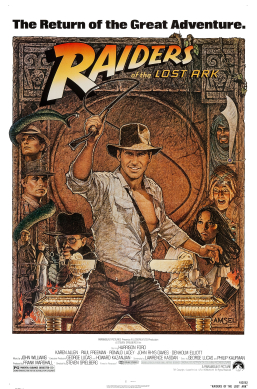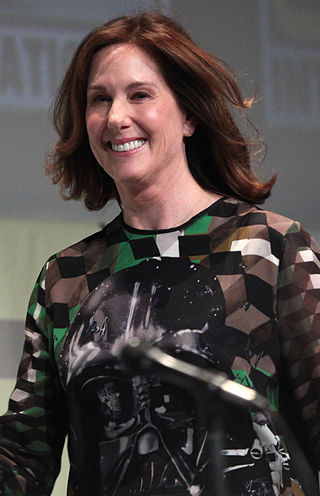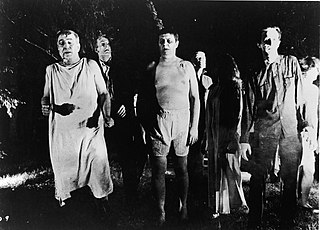
The 1980s was a decade that began January 1, 1980, and ended December 31, 1989.

Raiders of the Lost Ark is a 1981 American action-adventure film directed by Steven Spielberg from a screenplay by Lawrence Kasdan, based on a story by George Lucas and Philip Kaufman. Set in 1936, the film stars Harrison Ford as Indiana Jones, a globetrotting archaeologist vying with Nazi German forces to recover the long-lost Ark of the Covenant which is said to make an army invincible. Teaming up with his tough former romantic interest Marion Ravenwood, Jones races to stop rival archaeologist René Belloq from guiding the Nazis to the Ark and its power.

Edward Regan Murphy is an American comedian, actor, and singer. He shot to fame on the sketch comedy show Saturday Night Live, for which he was a regular cast member from 1980 to 1984. He is widely recognized as one of the greatest comedians of all time. Murphy has received accolades such as the Golden Globe Award, a Grammy Award, and an Emmy Award as well as nominations for an Academy Award and a BAFTA Award. He was honored with the Mark Twain Prize for American Humor in 2015 and the Cecil B. DeMille Award in 2023.

E.T. the Extra-Terrestrial is a 1982 American science fiction film produced and directed by Steven Spielberg and written by Melissa Mathison. It tells the story of Elliott, a boy who befriends an extraterrestrial, dubbed E.T., who is left behind on Earth. Along with his friends and family, Elliott must find a way to help E.T. find his way home. The film stars Dee Wallace, Henry Thomas, Peter Coyote, Robert MacNaughton and Drew Barrymore.

Cornelius Crane "Chevy" Chase is an American comedian, actor, and writer. He became the breakout cast member in the first season of Saturday Night Live (1975–1976), where his recurring Weekend Update segment became a staple of the show. As both a performer and a writer on the series, he earned two Primetime Emmy Awards out of four nominations.
Modern animation in the United States from the late 1980s to the early 2000s is frequently referred to as the renaissance age of American animation. During this period, many large American entertainment companies reformed and reinvigorated their animation departments, following the dark age, and the United States had an overall profound effect on animation globally.
A slasher film is a subgenre of horror films involving a killer stalking and murdering a group of people, usually by use of bladed or sharp tools. Although the term "slasher" may occasionally be used informally as a generic term for any horror film involving murder, film analysts cite an established set of characteristics which set slasher films apart from other horror subgenres, such as monster movies, splatter films, supernatural and psychological horror films.
The decade of the 1970s in film involved many significant developments in world cinema.

Kimila Ann Basinger is an American actress. She has garnered acclaim for her work in film, for which she has received various accolades including an Academy Award, a Golden Globe Award, a Screen Actors Guild Award, and a star on the Hollywood Walk of Fame. Initially a TV starlet, she shot to fame as a Bond girl in 1983 and enjoyed a long heyday over the next two decades. In 2011 Los Angeles Times Magazine ranked her third on the "50 Most Beautiful Women In Film".

A blockbuster is a work of entertainment—typically used to describe a feature film produced by a major film studio, but also other media—that is highly popular and financially successful. The term has also come to refer to any large-budget production intended for "blockbuster" status, aimed at mass markets with associated merchandising, sometimes on a scale that meant the financial fortunes of a film studio or a distributor could depend on it.

Kathleen Kennedy is an American film producer and president of Lucasfilm. In 1981, she co-founded the production company Amblin Entertainment with Steven Spielberg and her eventual husband Frank Marshall.

Edward Ernest "Judge" Reinhold Jr. is an American actor who is best known for his work in Hollywood films during the 1980s. He has starred in several popular films such as Stripes (1981), Fast Times at Ridgemont High (1982), and Ruthless People (1986). He has co-starred in all of the films in the Beverly Hills Cop and The Santa Clause franchises.
Peter Hyams is an American film director, screenwriter and cinematographer known for directing 1977 conspiracy thriller film Capricorn One, the 1981 science fiction-thriller Outland, the 1984 science fiction film 2010: The Year We Make Contact, the 1986 action/comedy Running Scared, the comic book adaptation Timecop, the action film Sudden Death, and the horror films The Relic and End of Days.
Hong Kong action cinema is the principal source of the Hong Kong film industry's global fame. Action films from Hong Kong have roots in Chinese and Hong Kong cultures including Chinese opera, storytelling and aesthetic traditions, which Hong Kong filmmakers combined with elements from Hollywood and Japanese cinema along with new action choreography and filmmaking techniques, to create a culturally distinctive form that went on to have wide transcultural appeal. In turn, Hollywood action films have been heavily influenced by Hong Kong genre conventions, from the 1970s onwards.

Cinematic exhibition of the B movie, defined as a relatively low-cost genre film, has declined substantially from the early 1980s to the present. Spurred by the historic success of several big-budget movies with B-style themes beginning in the mid-1970s, the major Hollywood studios moved progressively into the production of A-grade films in genres that had long been low-budget territory. With the majors also adopting exploitation-derived methods of booking and marketing, B movies began to be squeezed out of the commercial arena. The advent of digital cinema in the new millennium appeared to open up new opportunities for the distribution of inexpensive genre movies.
Cinecom Pictures was an independent film company founded in 1982 by Ira Deutchman, Amir Malin and John Ives. Its first release was Robert Altman's Come Back to the Five and Dime, Jimmy Dean, Jimmy Dean.

The Disney Renaissance was a period from 1989 to 1999 during which Walt Disney Feature Animation returned to producing critically and commercially successful animated films. These were mostly musical adaptations of well-known stories, similar to the films produced during the era of Walt Disney from the 1930s to 1960s. The resurgence allowed Disney's animated films to become a powerhouse of successes at the domestic and foreign box office, earning much greater profits than most of the Disney films of previous eras.

Jim Carrey is a Canadian and American actor and comedian who has appeared in various feature films, television films/series, along with one video game appearance. He is one of the top-50 highest-grossing actors of all time at the North American box office, with over $2.5 billion total gross and an average of $94.3 million per film. He has been involved with thirteen films that grossed over $250 million at the worldwide box office; the highest-grossing film being Bruce Almighty. Carrey gained his first lead role on the short-lived television series The Duck Factory in 1984, playing a young cartoonist. His first starring role in film was the 1985 comedy horror Once Bitten, with Lauren Hutton as a vampire countess and Carrey playing her victim. He landed supporting roles in films, such as Peggy Sue Got Married (1986), The Dead Pool (1988) and Earth Girls Are Easy. In 1990, Carrey received his commercial breakthrough on Fox's In Living Color (1990–1994), where he displayed his character work.












